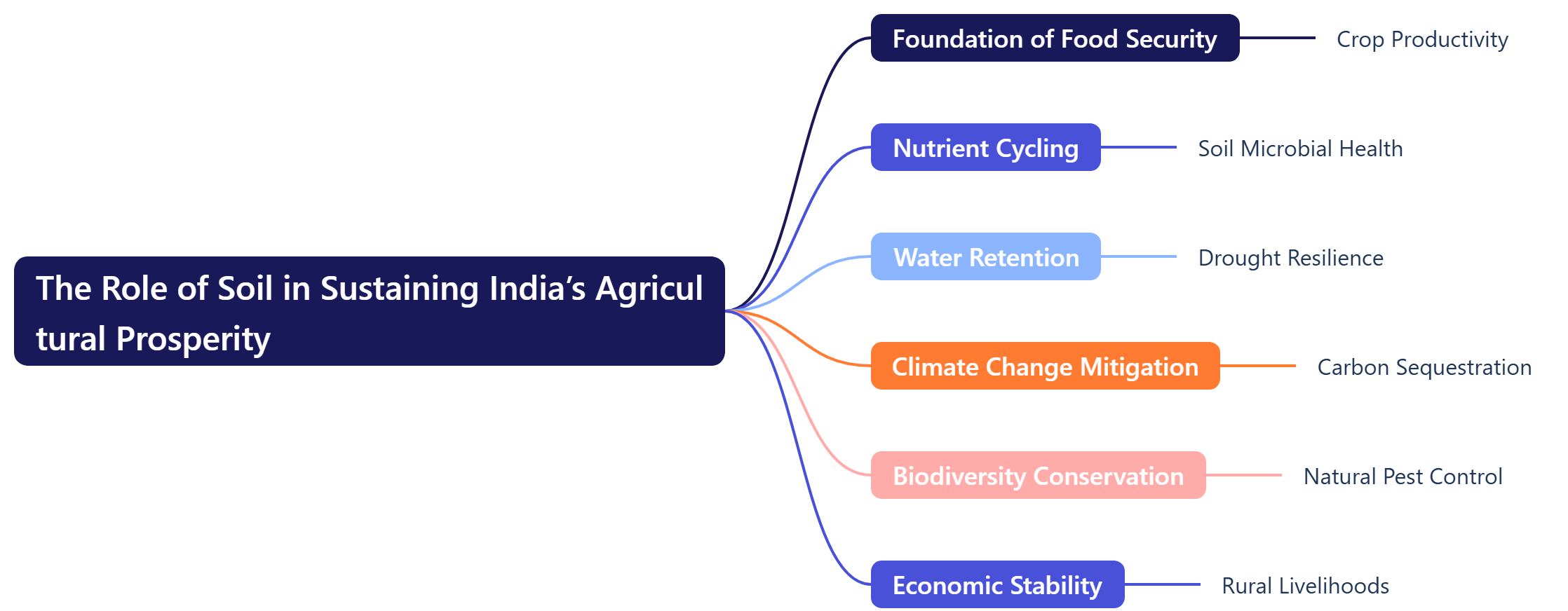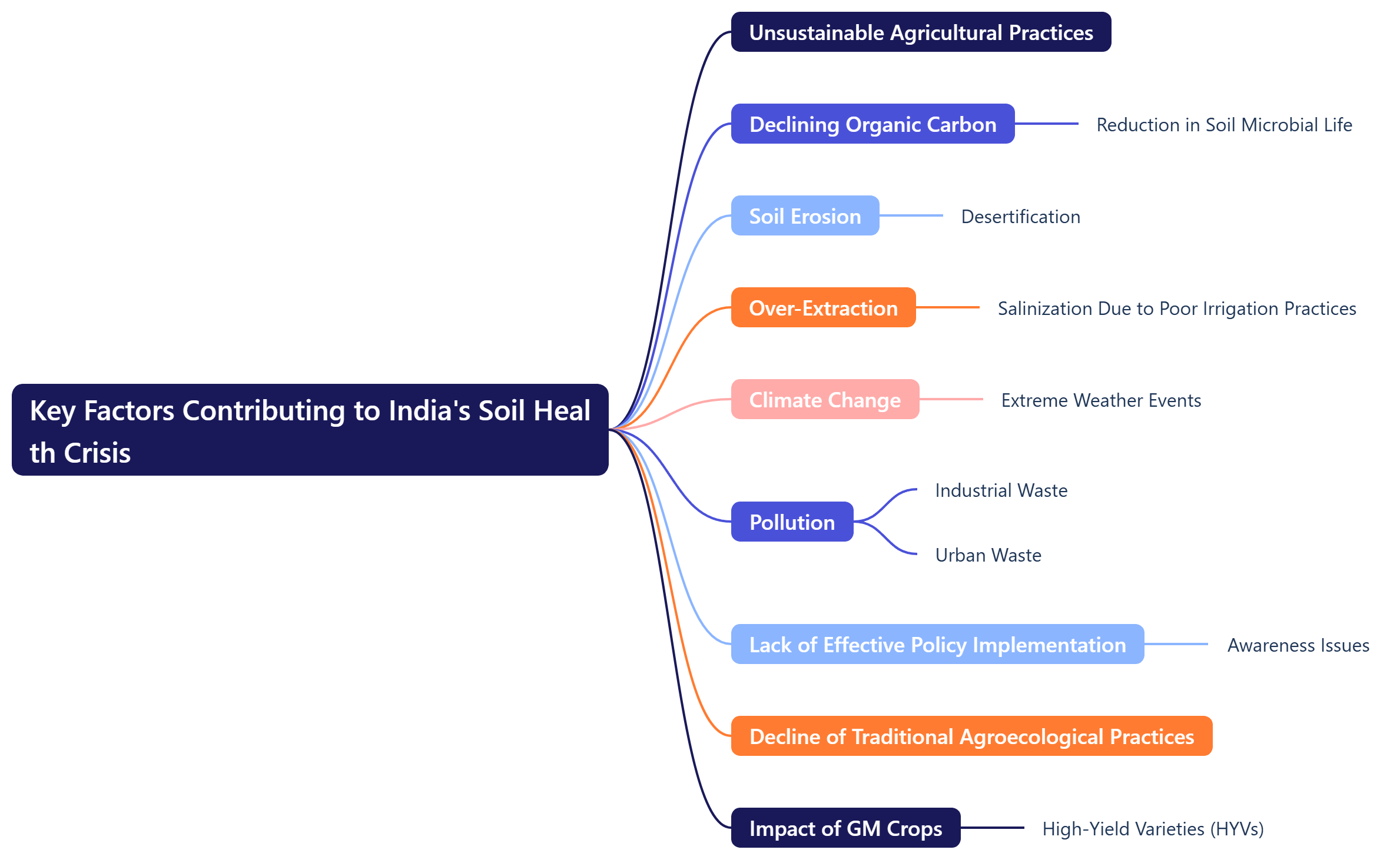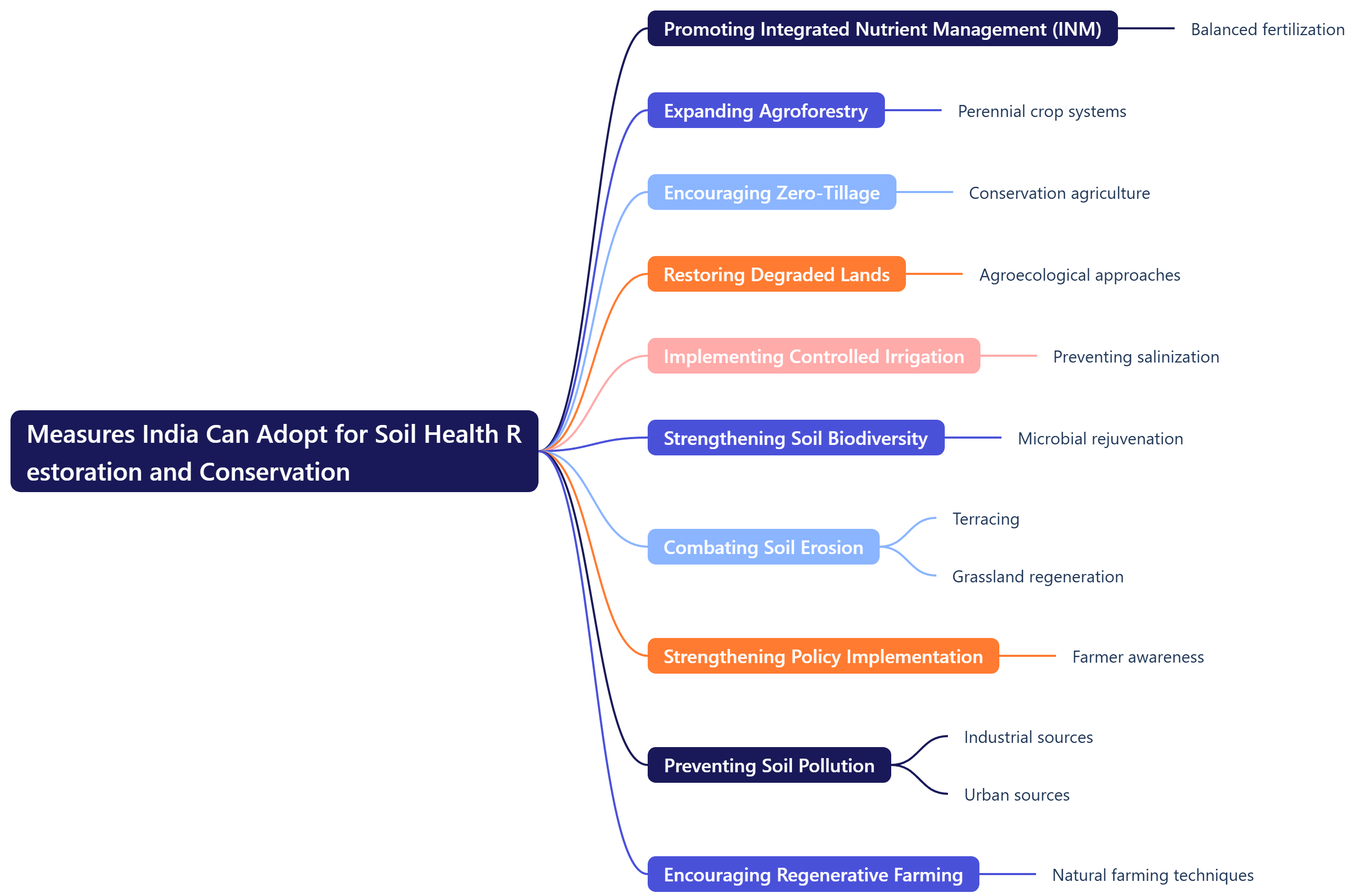India’s Soil Health Crisis: The Impact of Imbalanced Fertilizer Use
(Relevant for GS paper-3, Environment and Ecology)
| India’s soil health crisis is primarily driven by an imbalanced fertilizer policy that heavily subsidizes urea, leading to excessive nitrogen application. The current NPK ratio of 7.7:3.1:1 is significantly skewed compared to the ideal 4:2:1, highlighting a critical nutrient imbalance in agricultural soils.
Over-reliance on nitrogen-based fertilizers, combined with inadequate use of phosphorus, potassium, micronutrients, and organic manure, has resulted in declining soil productivity. This imbalance not only affects crop yields but also depletes soil fertility over time. As India strives to secure food production for its growing population, balanced nutrient management and policy reforms are urgently needed to restore soil health and sustain agricultural productivity. The Role of Soil in Sustaining India’s Agricultural Prosperity
1. Foundation of Food Security and Crop ProductivitySoil serves as the primary medium for plant growth, directly impacting crop yields, nutrient absorption, and overall agricultural output. The fertility of Indian soils supports the production of staple crops such as rice, wheat, and pulses, ensuring food security for 1.4 billion people. Diverse soil types, including alluvial soil in the Indo-Gangetic plains and black soil in Maharashtra, enable varied cropping patterns across the country. According to the FAO, 95% of global food production depends on soil, making its conservation vital for India’s agricultural sustainability. In 2022-23, India recorded an all-time high food grain production of 329.7 million tonnes, with oilseed production reaching 41.4 million tonnes, underscoring the significance of fertile soil in boosting agricultural output. 2. Nutrient Cycling and Soil Microbial HealthHealthy soil acts as a natural nutrient reservoir, supplying essential elements like nitrogen, phosphorus, and potassium for plant growth. Soil microbes decompose organic matter, fix atmospheric nitrogen, and enhance fertility, playing a crucial role in sustaining agricultural ecosystems. India’s organic farming movement, incorporating techniques like vermiculture and biofertilizers, relies on nutrient-rich soils. Without effective nutrient cycling, agricultural productivity declines, increasing reliance on chemical fertilizers. 3. Water Retention and Drought ResilienceSoil functions as a natural sponge, regulating water infiltration, retention, and drainage to ensure stable crop growth. High organic matter content improves water-holding capacity, reducing irrigation demand and making crops more resilient to erratic monsoons. In drought-prone regions like Rajasthan and Bundelkhand, soil moisture conservation techniques such as mulching and cover cropping help maintain agricultural productivity. Meanwhile, well-structured soils prevent waterlogging and root diseases in high-rainfall areas. 4. Climate Change Mitigation and Carbon SequestrationSoil plays a key role in carbon sequestration, absorbing and storing carbon to help mitigate climate change impacts on agriculture. Carbon-rich soils stabilize temperatures and prevent desertification. Adopting agroforestry and conservation agriculture enhances soil carbon storage, reducing greenhouse gas emissions. Research suggests that agricultural soils have the potential to absorb 3–8 gigatons of CO₂ annually for 20–30 years, contributing to climate stabilization. 5. Biodiversity Conservation and Natural Pest ControlHealthy soils support a diverse ecosystem of microorganisms, fungi, and insects that contribute to natural pest control. Organisms like earthworms and mycorrhizal fungi enhance soil aeration and nutrient absorption. A balanced soil ecosystem reduces reliance on chemical pesticides, making agriculture more sustainable and cost-effective. Recent studies indicate that farms with high soil biodiversity experience fewer pest outbreaks compared to degraded soils. 6. Economic Stability and Rural LivelihoodsSoil fertility is directly linked to farm income, as healthier soils lead to higher yields and better market prices. With nearly two-thirds of India’s population dependent on agriculture, soil health plays a critical role in economic stability and employment. Fertile soils lower input costs by reducing dependence on fertilizers and pesticides, improving farmers’ profit margins. Additionally, soil-based agro-industries, such as organic farming and compost production, create livelihood opportunities in rural India. Key Factors Contributing to India’s Soil Health Crisis
1. Unsustainable Agricultural PracticesThe excessive use of chemical fertilizers, pesticides, and monocropping has severely degraded soil fertility, leading to nutrient imbalances. Intensive farming in states like Punjab and Haryana, driven by MSP-backed wheat-rice cycles, has resulted in severe soil depletion. Additionally, over-tillage and deep plowing disrupt soil structure, reducing its capacity to retain water and nutrients. According to the 2022 State of India’s Environment Report, 30% of India’s land is facing degradation. 2. Declining Organic Carbon and Soil Microbial LifeSoil organic carbon (SOC) is essential for maintaining fertility, yet rapid depletion due to insufficient organic matter incorporation has worsened soil conditions. The widespread burning of crop residues in the Indo-Gangetic belt eliminates organic matter instead of replenishing soil nutrients. Over-reliance on synthetic fertilizers disrupts microbial ecosystems, hindering nutrient cycling. Additionally, deforestation and urbanization further strip the soil of its natural organic content.
3. Soil Erosion and DesertificationDeforestation, overgrazing, and poor water management have accelerated soil erosion and land degradation, particularly in semi-arid regions. Additionally, unsustainable mining and industrial activities strip away topsoil, reducing the land’s agricultural potential. According to the Desertification and Land Degradation Atlas of India (SAC 2021), 97.85 million hectares of land—29.77% of India’s total geographical area—are degraded. 4. Over-Extraction and Salinization Due to Poor Irrigation PracticesUnscientific irrigation methods, including excessive groundwater extraction and flood irrigation, have led to soil salinity, alkalinity, and waterlogging.
5. Climate Change and Extreme Weather EventsUnpredictable weather patterns, including erratic monsoons and rising temperatures, are accelerating soil degradation.
6. Pollution from Industrial and Urban WasteThe unchecked dumping of heavy metals, industrial effluents, and plastic waste has resulted in the toxic contamination of agricultural soils.
7. Lack of Effective Policy Implementation and AwarenessDespite initiatives like the Soil Health Card (SHC) program, the adoption of sustainable practices remains low due to limited farmer awareness and inadequate follow-up.
8. Decline of Traditional Agroecological PracticesTraditional organic farming techniques such as green manure, crop rotation, and agroforestry have diminished due to the push for high-yield, chemical-dependent crops.
9. Impact of Genetically Modified (GM) Crops and High-Yield Varieties (HYVs)The introduction of GM crops and HYVs has intensified nutrient depletion, as these crops demand higher fertilizer inputs.
Measures India Can Adopt for Soil Health Restoration and Conservation
1. Promoting Integrated Nutrient Management (INM) for Balanced FertilizationIndia needs to transition from excessive chemical fertilizer use to Integrated Nutrient Management (INM), which combines organic manure, biofertilizers, and judicious synthetic inputs.
2. Expanding Agroforestry and Perennial Crop SystemsIntegrating trees with agriculture under the National Agroforestry Policy (NAP) enhances soil organic carbon, prevents erosion, and increases farm income.
3. Encouraging Zero-Tillage and Conservation AgricultureAdopting zero-tillage farming minimizes soil erosion, enhances microbial activity, and conserves moisture, particularly in wheat-rice cropping systems.
4. Restoring Degraded Lands Through Agroecological ApproachesSoil restoration must adopt agroecological principles that integrate natural ecosystems to improve soil structure and fertility.
5. Implementing Controlled Irrigation and Preventing SalinizationOver-irrigation has caused soil salinity and waterlogging in the Indo-Gangetic plains. Transitioning to drip and sprinkler irrigation can mitigate these effects.
6. Strengthening Soil Biodiversity and Microbial RejuvenationEnhancing soil microbial diversity through bioinoculants, vermiculture, and mycorrhizal fungi can improve soil fertility and plant resilience.
7. Combating Soil Erosion Through Terracing and Grassland RegenerationHilly and semi-arid regions require terracing, check dams, and vegetative barriers to prevent topsoil loss.
8. Strengthening Policy Implementation and Farmer AwarenessBuilding farmer capacity through Krishi Vigyan Kendras (KVKs) and Farmer Producer Organizations (FPOs) must be prioritized.
9. Preventing Industrial and Urban Soil PollutionUnchecked dumping of industrial effluents and urban waste has caused toxic contamination of agricultural soils, particularly near cities.
10. Encouraging Farmers to Adopt Regenerative and Natural FarmingRegenerative farming techniques, such as Zero Budget Natural Farming (ZBNF) and permaculture, can enhance soil health while reducing dependency on external inputs.
ConclusionIndia’s soil health can be revitalized through integrated nutrient management, agroforestry, conservation agriculture, controlled irrigation, soil biodiversity enhancement, and policy reforms. Implementing these measures will ensure long-term agricultural sustainability, environmental resilience, and food security. |





2 comments